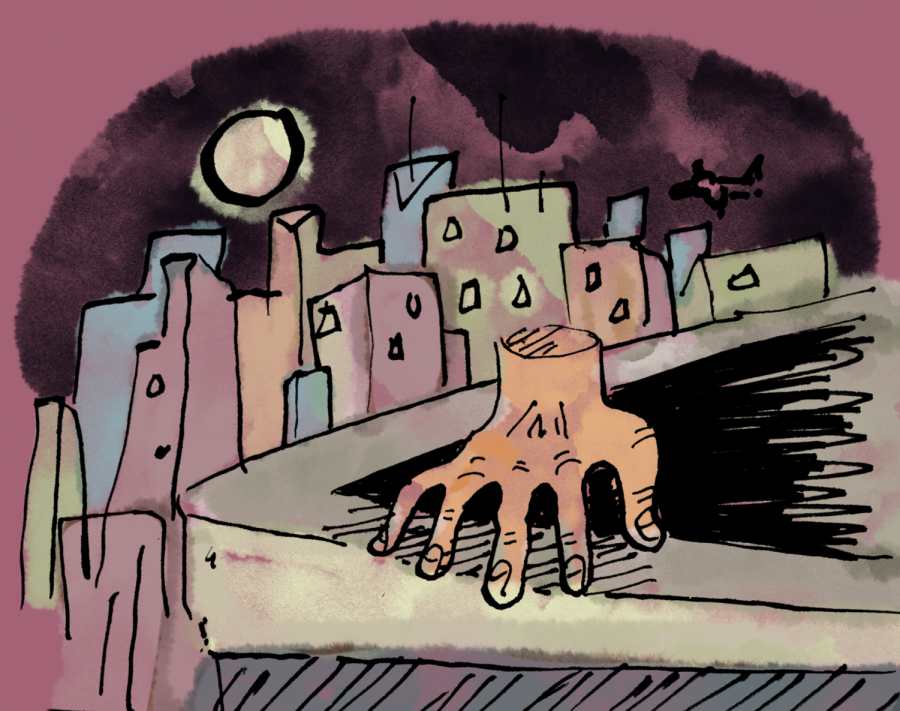I Lost My Body leaves its unique and bloody fingerprint all over the screen
May 7, 2021
The universal yet personal experience of growing up has become a cornerstone for cinema to a point of useless clichés. Whether it’s growing up with Greta Gerwig’s Lady Bird or any of the John Hughes ‘80s era films, there have been way too many movies about young adults trying to find themselves. But never like that of I Lost My Body, where a severed hand is quite literally trying to find himself while running — rather crawling — through Paris.
Acquired by Netflix in 2019 after its stunning premiere at the Cannes Film Festival, I Lost My Body crafts a unique lens to cast this familiar story. Through the intricate storytelling from writer-director Jérémy Clapin and Guillaume Laurant, and its remarkable and Oscar-nominated animation, this story developed into more than just a cliché. . .
Naoufel, a young man living in France after his parents’ death in Morocco, is forced to live an upsetting life with his cold uncle and abrasive cousin while working late-night shifts delivering pizza that gets delayed with his chronic lateness. Coming into his life at the perfect time of coincidence and fate is Gabrielle, who Naoufel swiftly launches into planning a way to win over.
His dream of escaping from his current circumstances gets cut short when he suddenly loses his hand in an accident that sparks the journey for the two to reconnect lead by his reanimated hand searching the Paris streets for Naoufel.
The hand, who goes criminally unnamed and unrecognized in the credits, is the true breakout star. Xilam Animation, which had previously animated shows and movies for children, lends its talents with capturing the fantastical by imbuing a hyper-real feel to the hand. Through its tilted center of balance, twitchy movements, expressive fingers and — of course — its ability to bleed, the uncanny personification of this alluring hand entices viewers to keep on watching.
The sentient star of the film proves incredibly intelligent as it dodges the many unique dangers of Paris for a hand including hungry rats, violent birds and massive cars all to find its body once again. Naoufel remarks to Gabrielle how “it must be peaceful to be cut off from the world like that. To see nothing, hear nothing.” If only he really knew.
Without this hero and its tense journey spliced between flashbacks of Naoufel’s life that reveal how the two got separated, I Lost My Body could easily become a slow indie romantic drama lacking any sense of urgency or passion.
The hand holds up the film’s best and most engaging features; the Frankensteined balance of reality and dreamy fiction, the omnipresent quest every 20-something protagonist needs and a reflective look into how fate and destiny don’t chokehold growth or prohibit life-changing choices like learning when to let go.
With an enchanting and lush soundtrack from Dan Levy of the Finnish-French indie band The Dø, the hand seeks to find its lost body by clawing its way through the story with its own perspective that crafts a truly unprecedented experience.
Assisting the drift into new territory, the style of I Lost My Body’s animation merges an uncanny realism with a creative look, creating individual atmospheres over certain scenes like the melancholy blue cast of Naoufel’s small room or the timeless black and white framing of his familial flashbacks. With much of the film following the hand, the camera’s perspective distorts everyday objects to appear ginormous and foreign, something the freedom in animation allows to be accentuated.
The rare premise of I Lost My Body allows for Naoufel’s story to breathe in small increments, revealing key moments and characteristics one by one to tell his bigger story of loss and accepting fate.
His childhood knack to record everything from his parents’ singing to tragically dire moments on cassettes and his current fascination to replay this soundtrack of his early years leaves him in the past, haunted by what has left him in the stuck situation he is in now. He becomes detached and lost, retelling the common stories of mourning loved ones, being a young adult with more questions than answers and the isolation many immigrants face in a new country.
The film’s timeline travels from his childhood in Morocco to the weeks leading up to his hand’s unfortunate amputation then the hand’s journey in the present. The collage of different decades and days bleed into each other with the intricate intimacy of seamless cuts to and from these conflicting times.
I Lost My Body’s handling of time calls back to a deeper history of storytelling that equally has characters and plots.
Fairy tales, in their earliest forms that were collected by the Brothers Grimm, Charles Perrault and others, were macabre and bloody, using terror as a didactic tool to deliver important lessons about growing up.
With a tragic backstory of dead parents, disdain from his current family, extreme magical elements, a love story, a young protagonist and an unhealthy dose of graphic details and gore, the film reminds the audience — both Netflix binge-watchers and disobedient children alike — that this is a fairy tale meant to augment the value of controlling one’s life into a rememberable tale of defying reality and finding a path in the world.
The rampant sanitization of fairy tales from Disney has scrubbed away the grit and grime to add sparkle and spectacle and family-appropriate fun, but this evolution of fairy tales isn’t unwarranted. It has ironed out some of the harder-to-digest fixtures into a more accessible story.
I Lost My Body returns to the rougher and less digestible format, a vanguard not predicting the future of storytelling but accepting its past. Some characters remain static for the plot’s sake, time toys around and macabre moments punch and sting just to do so. It can feel unnecessary, but these factors prove vital in ensuring Naoufel’s growth doesn’t continue to be stunted.
With so many tonal shifts, callbacks to the past and extensional crisis-inducing questions, I Lost My Body could feel too stretched out at times, trying to juggle everything with one hand tied behind its back — and another bleeding out on the floor.
But, instead of fearing to fumble, it accepts the clumsiness of young adulthood, growing up and the equally growing fear of both the future and past that mark the years as they come. This freedom to let itself become confusing, dizzying, lost, detached, isolating and weird doesn’t distract the story and instead bolster it as it follows and equally lose and detached hand finding its place in the world.
It is a reassuring acknowledgement that you don’t need a happily ever after to mature; that real life isn’t always a fairy tale despite its sometimes scary lessons.








